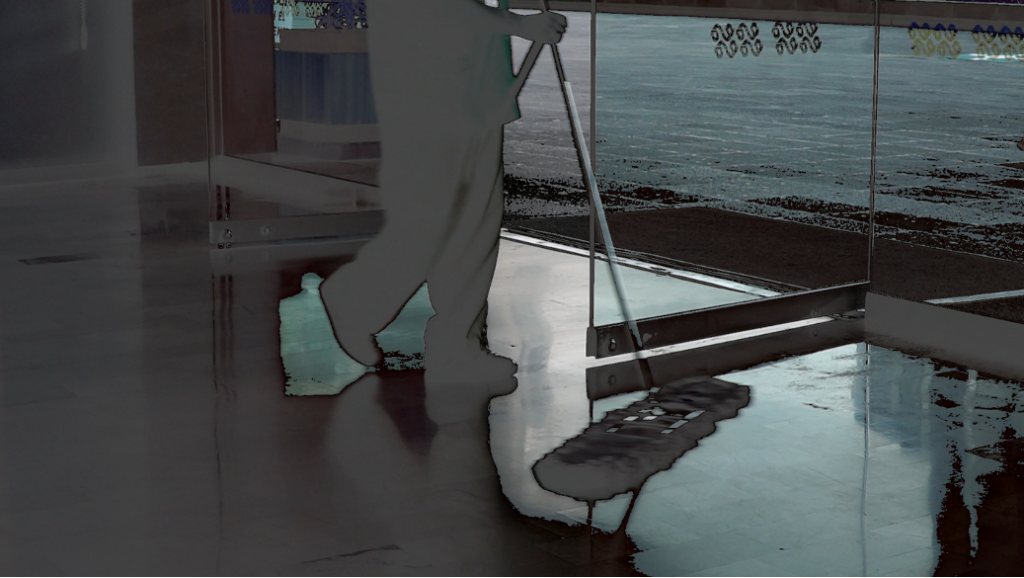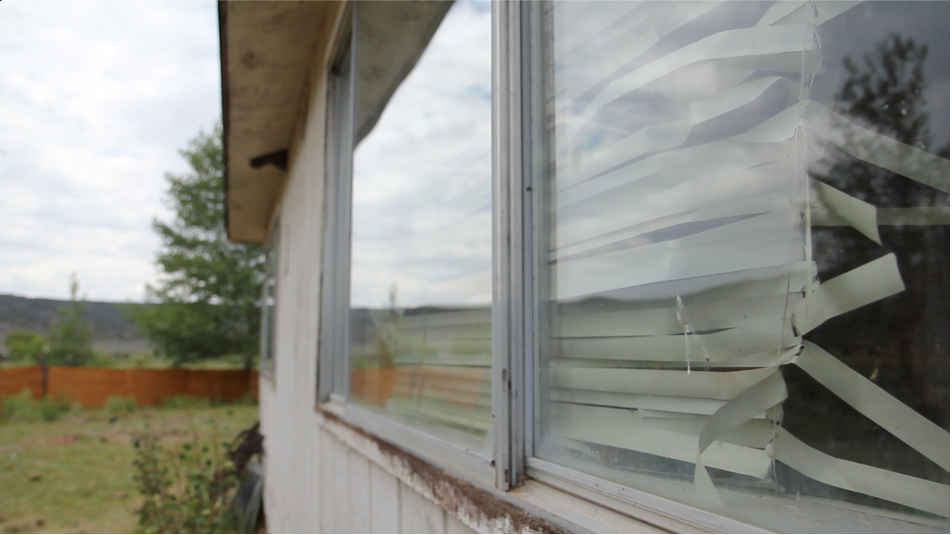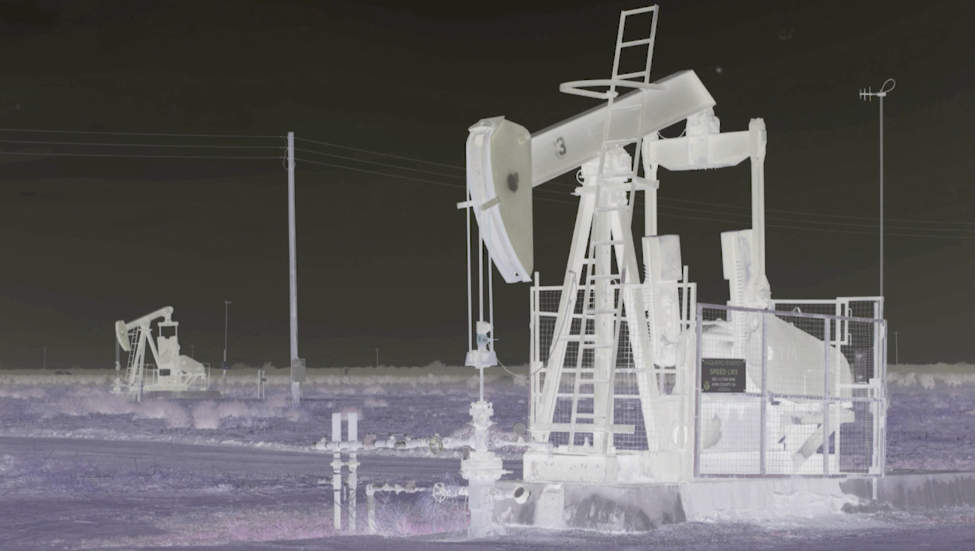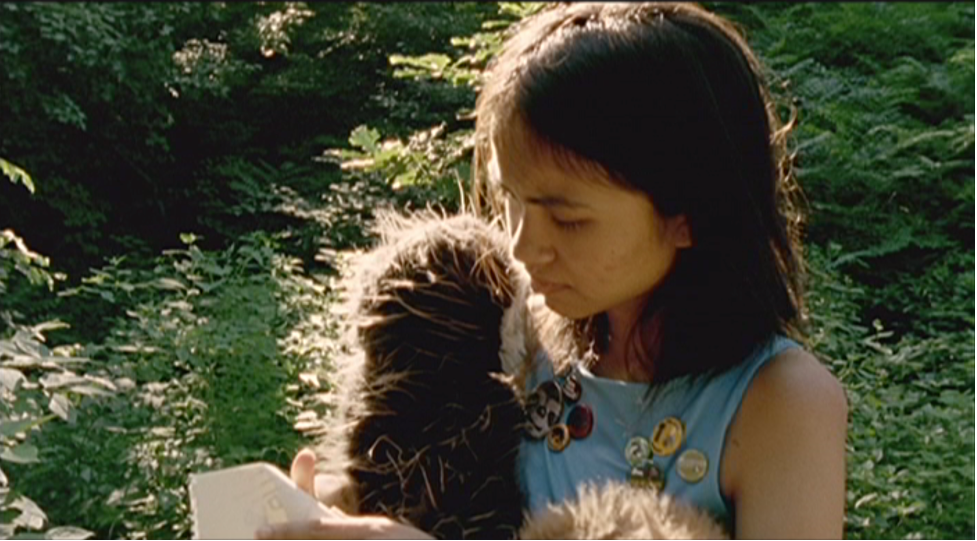Measuring the Invisible: Labor and Origin
Considering the works-in-progress of moving image artist R. Yun Matea: on giving form to the unseen, a democracy of objects that move at the same speed, and the body as container for non-linear time

Weather is wet, it doesn’t have joints. How snow just becomes rain, what’s that change called? Trees witness everything but they always look away.
Victoria Chang, “In the Open”from The Trees Witness Everything, 2022 1
For nearly two years, I have been deep in thinking about R. Yun Matea’s films. I have delighted in the way that they occupy space in my mind, as I witness their imprint in the many striking perceived silences and pauses of daily life. The way a window shade is bent, the way grasses brush and hum against one another, and how a cow might look onward intently and vacantly. Of the many thoughts and sensations they have nudged in me, I choose to begin at the questions these moving images have provoked. In what ways do we measure the invisible? And, in doing this important work of measuring, how do we find the means to lift the veil of invisibility?
Matea’s work provides form to that which, in great part, is unseen and unwitnessed by the masses. The locations and collections traversed by the artist are personal (even if open to the public) and close, without being willed to Matea’s own desires and wantings. Her films are a kind of measurement. In selecting from her work, I choose to focus on the works-in-progress. These are divided into three categories: Synchronicity, Material Democracy, and Undertone/Undertow.
A work-in-progress or WIP or #WIP is inherently about the future. That word, “progress,” is a careful (maybe even hopeful) reassurance against stagnation. The work-in-progress lives always with one foot in the present, and all other limbs reaching forward into however many years, days, and minutes that it might take to complete. In fact, its completion might be its lack of resolution. To which the audience’s responsibility might be to accept its undone-ness. It is a resistance to the model of produce and consume. In its very limbo state, a work-in-progress becomes radical. Sometimes these works remain partial to being in utero—forever amalgamated as in-progress. These important and unavoidable pieces of culture are thrown into a vortex of unending possibility. This kind of visual culture is a reclamation of time.

Synchronicity
the future as topic caricature condemns instance
Abigail Child, Mob, 1994 2
There is a silent and steady undercurrent of anticipation thrumming throughout Matea’s films. The brushing of a push broom across polished museum floors at the Museo Nacional de Antropología in Cuidad de México. I take this sweeping in as I watch Tzolk’in / Count of Days—a view from the floor. We are at the angle of the broom’s vision. An interplay of our own object-ness being reflected back to us in a space that is dedicated to preserving and archiving objects of human civilizations. By effect—we become part of the archive by viewing at the level we are seeing. We might be even somewhere below the archive.
We might be simply the same as the floor. And in many ways, we are all of those things as they are a part of us. We are the objects, we are the broom, we are the floor, we are the feet that move the broom along and we are the rain. The broom is the activator—literally pushing us throughout the plane of view. The rain is the true catalyst, though; it is neither plaintive nor bright. It simply is. Without the downpour, the gallery attendant—who we see only at the legs—would have no need to mop the water droplets off the ground. We would cease to witness this figure perform this act of care. The observation of rain falling. A great disruptor.
Synchronicity is important to Matea’s visual culture. And, the glass architecture could be both prescient and post-script to Iñigo Manglano-Ovalle’s (an artist born in Madrid who resides and works in Chicago) Always After (The Glass House)3. While the last time I saw Manglano-Ovalle’s conceptual, multidisciplinary work was at MASS MoCA in North Adams, MA,4 his film has resonated with me for over 12 years. Art and our experiences with it are often like a careful haunt. These two artists, while never referencing one another and speaking of differing terms, do orbit one another in my mind.
With just the right incantation, there is a kind of beckoning reunion that occupies a non-linear time. Matea shows us the glass architecture pre-shatter; Manglano-Ovalle’s glass architecture is splintered and broken. Part of the glass house’s appeal is the inevitability of shatter. Something so clear, something reflective and mirrored suddenly crystalized. While in Tzolk’in / Count of Days, we can measure the invisible with glides of a push broom, and in the seconds of time we can also offer our attention to surveying the glass house and the glass doors which beg to be broken. A brokenness that can remind us of other shatterings—breaking windows and glass in a different kind of protest and rupture outside of museums and galleries. Even in our streets. Near our homes. In our homes. Glass we will sweep from the streets. Tiny shards of glass that the rain might wash away.
Material Democracy
Habría que escribir en todo caso de lo acalladas que están las voces. Decir de la palabra e imagen callada a fuerza de fuego y palo, de las bocas limpias amordazadas a fuerza de oscuridad. Decir de las manos trabajadoras ahora mutiladas. Decir también cómo la voz y la palabra, la imagen y la mirada, las manos en fin, avanzan subterráneas para emerger justo a la mitad del alba, para que la palabra e imagen de tanta voz y tanta mirada salten incontenibles, incorporándose en los actos del amanecer.
Grupo Proceso Pentágono, 19775
In much the same way that Brazilian provocateur Hélio Oticica (active from 1954-1980) and the agents of community refuge Grupo Proceso Pentágono (active between 1976 and 1985) think of the body as a site for the political, in Matea’s films there is a democratization that exists, allowing all that comes through the frame to take on a similar speed. By speed here I do not mean to indicate fastness or slowness, but a timeliness in alignment of objects and figures in the frame. They all radiate with the same glow—none shining more brightly than another. The camera does not lead us into narrative nor hierarchy.
In North/Central, a cow’s body can seem as important as a broken blind, and just as necessary as the narrator’s voice which enters our ears. The visceral experience of these films makes it evident that these experiences and spaces occupy real time. We are being invited into a space by figures and shapes that take up room and insist upon their existence as vital. This might be a democratic witnessing that Matea has led us into—and it is not easy to conjure. Matea makes this democratization appear effortless, but there is great labor here.
To understand this kind of democratization, one must be at a place of knowing that they, too, are a part of it all. To capture this speed requires an eye of less judgment—it is a state that is less about telling and more about enacting. She invites us to experience our senses through moving images. There is a difference. The difference is how we use our bodies to respond to the light projections and sound waves that envelop us.

Work requires the body of any being, and we live during a time in which objects are an extension of our being. These tools toil and labor—doing our bidding while we occupy ourselves in other endeavors (despite that these tools may require our continued guidance and maintenance.) The oil rig is one tool that exemplifies this extension of the human appendage. While watching the oil rig monotonously keeping time, it is a strange and extraterrestrial pulse, despite our awareness of the terrestrial extractions that occur. As Peter Galison and Caroline Jones once said in resistance to the very popularized notion of the Anthropocene: “The circuit—of drill, spill, ‘clean up,’ and drill again—relies on such systems of images and occlusions, in which the production of invisibility forms an aesthetic chiaroscuro to all the tragic, sublime, and subaquatic flows.”6
How does the body reaffirm that time is not linear? The colonized mind would like us to fantasize that time is linear. Points following one after another, marching forward into an end point that is clearly outlined. Time, rather, is cyclical. It folds upon itself, and retells experiences that might require us to look again and act with better intention. We drift forward, one foot in front of the other. A drill into the earth. Land that was stolen. A body that desires, land that is desired. Our bodies and the sounds we are experiencing prove that there are too many interruptions, too many memories, too many moments that move us into and out of line. We are shapeshifting our way through the world, whether we acknowledge conscious knowing of it or not. The body is a container to hold it all together. Our schedules and planners are an illusion of order. How we labor and for how long is always linked to the body and its knowledge of time. So why do we refuse our bodily knowing?
Matea’s North/Central reminds me to re-remember.
Undertone/Undertow
We were led, not knowing whither, Like mirages before us there receded Cities built by miracle, Wild mint was laying itself beneath our feet, Birds travelling by the same route as ourselves, And in the river fishes swam upstream; And the sky unrolled itself before our eyes.
Arseniy Tarkovsky, “First Meetings” from Andrey Tarkovsky Sculpting in Time, 1986 7

Weather, tornadoes, grasses, dust, a truck, conversations had while driving. An oil rig pushes up and down from the ground. A sense of quiet dread in the frame. There is a give and take, a reciprocity on the screen with San Joaquin—a recent, not in-progress, work—that feels to shimmer with a quiet veil of tranquility, despite the shifting images that reveal disruption. Perhaps this is what vibrates beneath our consciousness at all times. A knowing of catastrophes, both occurring and on the horizon. The inevitability of disaster amongst all of this beauty we encounter.
In Now let the Sloth come on Stage, we are met with the ways that Cambodian-Americans in Philadelphia cope with intergenerational trauma and reconcile the dreams that were impressed and pressed upon them by family, lineage, borders, and nations.
The images are embalmed and cocooned in anxiety. The anxiety of bearing witness. The anxiety of being othered, of origin, of recognition. An anxiety of becoming. No matter how gentle the filmmaker’s approach, the result is a sharp slice to our perception. An interjection to our own awareness. Like the radiant and misplaced dreams of Mababangong Bangungot (Perfumed Nightmare)8, by Filipino filmmaker Kidlat Tahimik, Matea too steps into a space of acknowledging neocolonialism and capitalism’s grip on every facet of our lives, while also exposing that which is tender.
Like Mababangong Bangungot, Now let the Sloth come on Stage acknowledges how colonizer history has enacted violence and ill action, particularly toward those who inhabit skin that is not white. Brown skin of those who have been colonized and their own resources and industries weaponized against them by colonizers. The idealization of the American dream that leads so many to yearn for this false narrative. Whiteness has a way of absorbing everything around it—swallowing it so that the swallowed thing must escape its belly through a strange regurgitation. The only way out is through.
The images that Matea reveals in Now let the Sloth come on Stage, in their silences, in their quietness, easily become the loudest thing in the room. I can liken this to sound deprivation. The sound of one’s heart becomes so deafening that the reliable beats, which one might normally pay no mind to, suddenly can be felt with a thunder that is unparalleled. After bearing witness, we are forever changed. Our hearts beat in cadence differently. It is our job to catch up to them.

R. Yun Matea’s exhibition They became ill and their pages were left blank is on view at PAPA Projects through October 30, 2022. >> more information